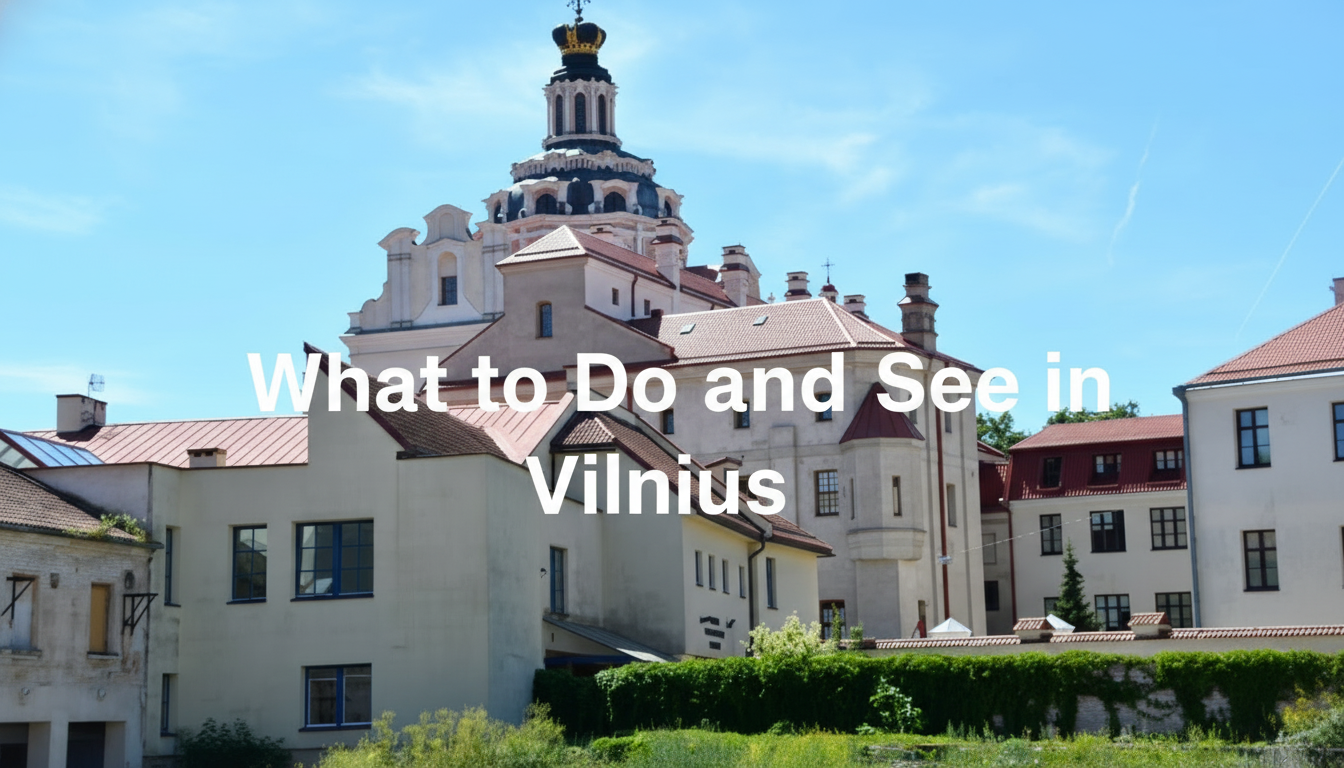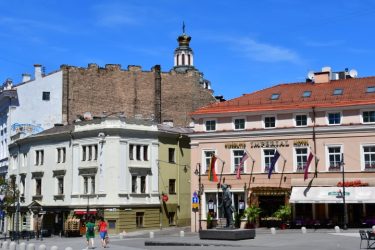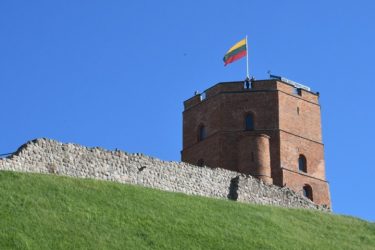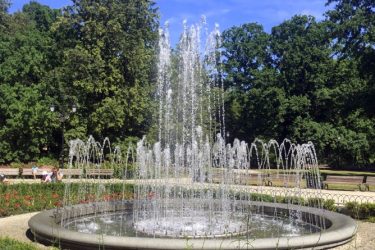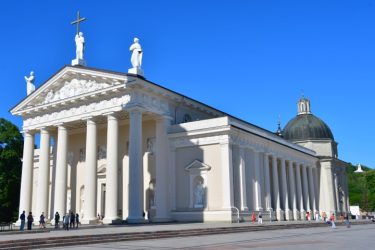Vilnius, the capital of Lithuania, is a fascinating place to visit in Eastern Europe since it offers a diverse range of historical, cultural, and architectural attractions. Vilnius is renowned for its magnificent Old Town, which has one of the largest remaining medieval neighborhood’s in Europe and is recognized as a UNESCO World Heritage site.
Explore the Old Town’s center, where well-preserved Gothic, Renaissance, Baroque, and Neoclassical buildings line cobblestone streets. Important monuments include the Gediminas Tower, which provides sweeping views of the city from its hilltop perch, and the beautiful Vilnius Cathedral with its neoclassical exterior. Deep insights into Lithuania’s history and cultural legacy can be gained from the National Museum of Lithuania and the nearby Gediminas Castle complex.
Must-see sites include the Gates of Dawn, the last of the city’s original gates, and the Church of St. Anne, a masterpiece of Gothic architecture. A renowned icon of the Virgin Mary is kept at the Gates of Dawn, drawing pilgrims from all over the world.
Vilnius is a creative and culturally active city as well. The bohemian center of the city, Uzupis district, became its own separate republic in 1997 and is now home to galleries, unique eateries, and artists. It’s an interesting place to explore because of its free spirit and artistic vibe.
Visit the Museum of Occupations and Freedom Fights, located in a former KGB building, for a more in-depth look at history. This museum offers a moving glimpse into Lithuania’s resistance and struggles throughout the Soviet era.
Take a stroll alongside the Neris River, take in the greenery of Bernardine Garden, or check out the vibrant local markets and modern food scene. Vilnius is a fascinating location for tourists looking for both historical depth and cultural vibrancy since it combines old-world elegance with contemporary vigor. In this article we will give you what you should do and see when you visit Vilnius.
Visit Vilnius Old Town
A trip through time is what visiting Vilnius Old Town offers: an enthralling fusion of culture, history, and architecture. This UNESCO World Heritage site, one of the largest remaining medieval neighborhoods in Europe, is well-known for its winding cobblestone lanes, gorgeous baroque architecture, and lively ambiance.
In the center of the Old Town, on Cathedral Square, is a great place to start your trip. The magnificent Vilnius Cathedral with its neoclassical façade and the Bell Tower, which provides sweeping city views, can be found here. Situated on a hill close by, the Gediminas Tower offers a breath-taking view and insights into the city’s colorful past.
As you go throughout Old Town, you will come across a variety of architectural designs. Visitors are in awe of the baroque beauty of St. Peter and St. Paul’s Church, while the delicate brickwork of the Gothic Church of St. Anne makes it stand out. Another highlight is the Presidential Palace, which features an exquisite neoclassical design.
The revered statue of the Virgin Mary at the Gates of Dawn, the last of the old city gates, draws both pilgrims and tourists. This location perfectly captures Vilnius’s profound spiritual and historical significance.
It is essential to visit Vilnius University, which is among the oldest in Eastern Europe. The old buildings and expansive courtyards showcase the intellectual legacy of the city. Notable features of the university are the fresco-adorned St. John’s Church and its library.
Explore the busy Pilies Street, which is dotted with cafes, stores, and street vendors, for a sense of the local way of life. You may buy handcrafted goods, savor traditional Lithuanian food, and take in the vibrant street entertainment here.
Vilnius Old Town is a vibrant, breathing section of the city where the past and current coexist peacefully, in addition to being a historical treasure trove. Whether you’re interested in architecture, history, or are just a curious visitor, a visit to Vilnius Old Town will provide you with an amazing and enlightening experience.
Gediminas Castle Tower in Vilnius
One of the most recognizable sites in Vilnius, Lithuania, is the Gediminas Castle Tower, which offers stunning city views in addition to historical value. The tower, which is perched atop Gediminas Hill and offers an intriguing look into the past of the Grand Duchy of Lithuania, is a relic of the city’s medieval defenses.
Vilnius was founded in the early 14th century by the fabled Grand Duke Gediminas, for whom the tower is called. Originally a section of a larger timber fort, Gediminas Castle was reconstructed in brick in the early 15th century, under the rule of Grand Duke Vytautas the Great. Even though just a small portion of the original building is still standing, the tower is nonetheless a proud representation of Lithuanian history.
A winding staircase leads to the summit of Gediminas Castle Tower, where visitors are rewarded with expansive views over Vilnius. Views of the expansive Old Town with its red-tiled rooftops, the contemporary cityscape beyond, and the verdant hills and forests in the vicinity may all be seen from this vantage point. When the city is bathed in a golden glow at sunset, the scene is especially breath-taking.
A tiny museum housed inside the tower features displays about the history of Vilnius and the castle. Informational displays, models, and artefacts give the tower’s historical significance and the events it has seen in perspective. Gediminas’ dream, in which an iron wolf howled atop the hill and motivated him to create the museum, is also explored in the exhibit.
From the city center, Gediminas Castle Tower is conveniently located. Visitors can ascend the steep hill using a funicular railway, or if they’re feeling very daring, they can stroll along a picturesque trail that leads to the top. Gediminas Castle Tower is a must-see location in Vilnius for anyone interested in history, photography, or just for a breath-taking perspective.
Stroll Through Užupis in Vilnius
Wandering about Vilnius, Lithuania’s lively and eccentric Užupis neighborhood is a singular experience brimming with artistic expression and a bohemian vibe. Užupis, often likened to Paris’s Montmartre or Copenhagen’s Freetown Christiania, is renowned for its innovative spirit and self-proclaimed autonomy.
Meaning “beyond the river,” Užupis is situated on the other side of the Vilnia River from the Old Town. On April 1, 1997, the district formally proclaimed itself the Republic of Užupis, with a constitution, a president, and even a small army of roughly twelve soldiers. This declaration, while primarily symbolic, captures the unique nature of the area and the aspirations of its people for independence and innovation.
A must-see is the Užupis Constitution, which is shown on several plaques along Paupio Street. It is a multilingual list of rights that includes wacky and philosophical ones like “Everyone has the right to be happy” and “Everyone has the right to make mistakes.” This light-hearted document captures the district’s attitude of freedom.
There are a ton of galleries, murals, and art installations to be found when exploring Užupis. Numerous artists reside in the district, and their creations can be found everywhere, converting the area into an outdoor gallery. Notable locations include the sculpture known as the Mermaid of Užupis, which is said to entice tourists to return to the region, and the Angel of Užupis statue, which represents artistic freedom.
Užupis’s cafes and pubs are the ideal places to unwind and take in the bohemian atmosphere. A lot of places serve as performance venues or galleries and host live music events, poetry readings, and art exhibitions. In addition, the neighborhood holds a number of festivals and cultural events all year long to further highlight its active community.
A stroll around Užupis offers a fascinating contrast to Vilnius’s historical grandeur, providing a window into a society where unconventionality is celebrated and inventiveness is valued above all else. Užupis is a destination that inspires and enchants, whether you’re exploring its creative offers, sipping coffee at a quirky café, or just taking in the distinct ambiance.
Visit the Museum of Occupations and Freedom Fights in Vilnius
The Museum of Occupations and Freedom Fights in Vilnius, Lithuania, provides an insightful and poignant look into the turbulent history of the nation during the 20th century. The museum, housed in a former KGB headquarters, is a sobering reminder of the atrocious occupations that Lithuania suffered under the Soviet Union and Nazi Germany.
Being the former home of the KGB, the infamous security organization of the Soviet Union, the building itself is a scary artefact. The museum’s displays, which describe the tyranny, resistance, and tenacity of the Lithuanian people, are set against an actual backdrop in this location.
Numerous displays that document the various occupation eras may be seen throughout the museum. Images, records, and individual items convey the narratives of people who experienced these periods. The basement, which houses the maintained cells where political prisoners were kept, questioned, and frequently tortured, is one of the most terrifying areas. The cramped, bleak surroundings of these cells provide a chilling look into the harsh reality that government opponents had to endure.
The museum also emphasizes the larger background of Lithuania’s liberation struggle, encompassing the partisan resistance movement that opposed Soviet rule following World War II and the nonviolent demonstrations that ultimately resulted in Lithuania’s independence in 1990. These historical events become more approachable and powerful when they are brought to life through multimedia exhibits and first-hand accounts.
Not only is a trip to the Museum of Occupations and Freedom Fights enlightening, but it is also incredibly moving. It celebrates the tenacity and bravery of those who battled for freedom while highlighting the significance of remembering and respecting the past. The museum is a potent symbol of Lithuania’s struggle from occupation to freedom as well as its continued adherence to democracy and human rights.
Relax in Bernardine Garden in Vilnius
Unwinding at Lithuania’s Bernardine Garden, which is close to the city center, provides a calm diversion from the busy metropolis. This exquisitely designed park, which is close to the ancient Old Town and the Vilnia River, is the ideal place for locals and guests to relax and take in the scenery.
Originally a portion of a monastic garden in the fifteenth century, Bernardine Garden, also known as Bernardinų Sodas, has a rich past. It has been painstakingly restored to create a tranquil haven with all the conveniences of the modern world, all while preserving its historic charm.
You will be welcomed by a variety of flora as you walk around the garden, featuring vibrant flower beds, well-kept lawns, and a variety of trees and shrubs. The park’s layout skillfully blends traditional and modern landscape architecture features to create a visually appealing experience for all visitors.
The garden’s focal point is its central fountain, which has benches all around it and provides a peaceful area to sit and unwind. A quaint rosarium with a wide variety of rose varieties that bloom in vivid hues all summer long may be found nearby. A monastic garden and a medicinal plant garden are only two of the themed areas in the garden that offer insights into past horticulture techniques.
Families can enjoy the secure playground that Bernardine Garden has to offer for their kids. Because of its great paths for cycling, jogging, and leisurely walks, the park is a well-liked spot for outdoor recreation.
The garden is more appealing because of its closeness to the Vilnia River, which also contributes to its tranquil atmosphere with its picturesque views and soothing sound of running water. People are frequently seen having picnics on the lawns or reading books beneath trees in the warmer months.
In addition, Bernardine Garden holds a number of concerts and cultural events, especially in the summer, which enlivens the otherwise tranquil surroundings. Bernardine Garden offers a pleasant haven in which to spend time with loved ones, have a romantic stroll, or just have a moment of alone.
Vilnius Cathedral
One of the most recognizable sites in the capital of Lithuania is the Vilnius Cathedral, often referred to as the Cathedral Basilica of St. Stanislaus and St. Ladislaus of Vilnius. Situated at the foot of Gediminas Hill in the center of Vilnius, this majestic cathedral is a key component of the city’s cultural and historical landscape.
The first wooden church was built by monarch Mindaugas, the first and only monarch of Lithuania, following his conversion to Christianity in the 13th century, which is when the cathedral’s history began. The cathedral was extensively rebuilt over the ages to become the magnificent neoclassical structure it is today. The architect Laurynas Gucevičius created its current shape in the late 18th century, capturing the opulence and grace of neoclassical design.
The striking portico of Vilnius Cathedral, including six colossal columns and statues of the Four Evangelists, is a prominent feature of the building’s façade. From its summit, the bell tower that is adjacent to the main building provides a panoramic view of Vilnius and was formerly a part of the city’s defines walls.
The cathedral is just as magnificent inside. Numerous chapels with excellent artwork, frescoes, and religious icons may be seen throughout the expansive interior. The silver tomb holding the saint’s relics and the elaborate Baroque embellishments of the Chapel of St. Casimir, the patron saint of Lithuania, are especially remarkable.
Being the location of several Grand Dukes of Lithuania’s coronations, Vilnius Cathedral is likewise very significant historically. It continues to be a hub for religious activity and the location of significant official and religious rituals.
The crypts and catacombs of the cathedral, which contain the remains of famous people from Lithuania’s past, including members of the royal family, are one of its distinctive features. These subterranean rooms offer interesting glimpses into the rich history of the nation through guided tours.
Vilnius Cathedral is a thriving element of the city’s cultural life in addition to being a religious and historical landmark. Its regular hosting of events, exhibitions, and concerts enhances its status as a communal hub in Vilnius. Vilnius Cathedral is a must-see for anybody visiting the Lithuanian capital, regardless of their interest in architecture, history, or spirituality.
Gates of Dawn in Vilnius
At Vilnius, Lithuania, the Gates of Dawn (Aušros Vartai) are a poignant symbol of faith and resiliency that draw tourists from all over the world. The Vilnius Madonna, also known as Our Lady of the Gate of Dawn, is an icon of the Blessed Virgin Mary that is kept inside this historic city gate, which is the only entry to the old city of Vilnius that still stands.
The Gates of Dawn, which were built as part of Vilnius’s defensive defenses in the sixteenth century, were an essential point of entry for pilgrims and travelers arriving from the east. Owing to the alleged healing abilities of the Virgin Mary image kept in its chapel, the gate eventually rose to prominence as a religious landmark.
The icon itself, which shows the Virgin Mary holding a baby Jesus, is a masterwork of Eastern Orthodox art. It is well recognized for its placid look and the feeling of tranquility it inspires in its followers. It is thought to have been painted in the 17th century by an unidentified artist.
People from many walks of life gather at the Gates of Dawn to honor the symbol and find spiritual comfort. Ex-votos and expressions of appreciation left by people who feel their prayers were answered or miracles performed adorn the chapel that houses the image.
Even in modern times, the Chapel of Our Lady of the Gate of Dawn and the Gates of Dawn remain sites of cultural significance and prayer. The location is a perfect representation of Vilnius’ rich religious history and its significance as a hub of devotion and faith in Lithuania. The Gates of Dawn provide a profound and unforgettable experience in the center of Vilnius, whether you are lured by its architectural history or spiritual significance.
Nightlife in Vilnius
A vibrant and varied nightlife that accommodates a broad spectrum of tastes and preferences can be found in Vilnius, Lithuania. The city becomes a hive of activity when the sun sets, fusing old world elegance with contemporary energy.
Vilnius’s Old Town, with its cobblestone lanes and centuries-old buildings housing a profusion of taverns, clubs, and live music venues, is the centre of the city’s nightlife. Particularly well-liked are Pilies Street and Vokiečių Street, which are teeming with activity and dotted with businesses that range from quaint taverns to chic cocktail clubs. Visit one of the many bars to sample traditional Lithuanian drinks like mead or kvas for a taste of the local flavor.
Užupis area, which is renowned for its bohemian atmosphere. This self-described “independent republic” is home to live music venues, unique bars, and art galleries. There’s a strong creative vibe in the region, which attracts artists and young professionals.
Vilnius also has a variety of clubs to suit a wide spectrum of musical preferences. One of the city’s top nightlife hotspots, Loftas is a former factory transformed into a cultural center that hosts live concerts, DJ sets, and art events. Opium Club delivers cutting edge DJ sets in a cozy environment for fans of electronic music.
Vilnius’s nightlife is heavily cantered around live music, with many venues featuring both local and foreign performers. The live bands that perform at the Tamsta Club are well-known, specializing in rock and jazz. The Vilnius Jazz Bar, which hosts performances by regional and worldwide musicians, is sure to please fans of jazz.
Vilnius’s late-night cafés and cafes are another feature that enhances its nightlife and is ideal for individuals who want to relax after a night of dancing and mingling. There’s always something tasty to savour in the city thanks to its broad culinary scene, whether it’s traditional Lithuanian fare or foreign food.
All things considered, Vilnius’s nightlife offers a unique experience to each and every visitor by fusing old world elegance with contemporary vibrancy.
Festivals in Vilnius
Vilnius, Lithuania, celebrates its rich cultural legacy and modern inventiveness with a plethora of colorful events held all year round. Vilnius has something to offer every kind of visitor, from contemporary art and music festivals to customary festivities steeped in Lithuanian culture.
Kaziuko Mugė, or St. Casimir’s Fair, is one of Vilnius’s most important festivals, and it takes place in March. Dating back to the 17th century, this customary crafts fair turns the city’s streets into a hive of activity. Tourists can peruse booths showcasing handcrafted items, regional cuisine, and elaborate palm weavings known as “verbos,” which are emblematic of Easter and spring.
Held annually in March and April, the Vilnius International Film Festival (Vilnius IFF), also known as Kino Pavasaris, is another important event. This esteemed festival draws filmmakers and moviegoers from all over the world with its wide array of foreign and Lithuanian film selections. For film enthusiasts, screenings, workshops, and conversations create a lively environment.
June marks the start of the Vilnius Festival, which honors classical music in the summer with concerts by world-class orchestras, soloists, and conductors in magnificent settings including the National Philharmonic Hall and Vilnius Cathedral. This festival draws music lovers and enhances the city’s cultural scene.
For something more modern, check out the popular September urban music and arts festival, Loftas Fest, which takes place in the repurposed industrial site of Loftas. This festival attracts a youthful, diverse population with its live music, art installations, street food, and fashion presentations.
Another highlight is the October Vilnius Jazz Festival, which provides a place for both local and foreign jazz performers to perform in different parts of the city. This festival has a long history of showcasing avant-garde and inventive jazz.
The largest literary festival in the Baltic nations, the Vilnius Book Fair, takes place in February as another way Vilnius celebrates its literary legacy. With a schedule of readings, talks, and book signings, it draws writers, publishers, and book enthusiasts.
Vilnius is a dynamic and culturally rich destination that offers tourists a year-round calendar of events that celebrate the city’s traditions, arts, and energetic spirit. These festivals are just a few of the many that contribute to this.



